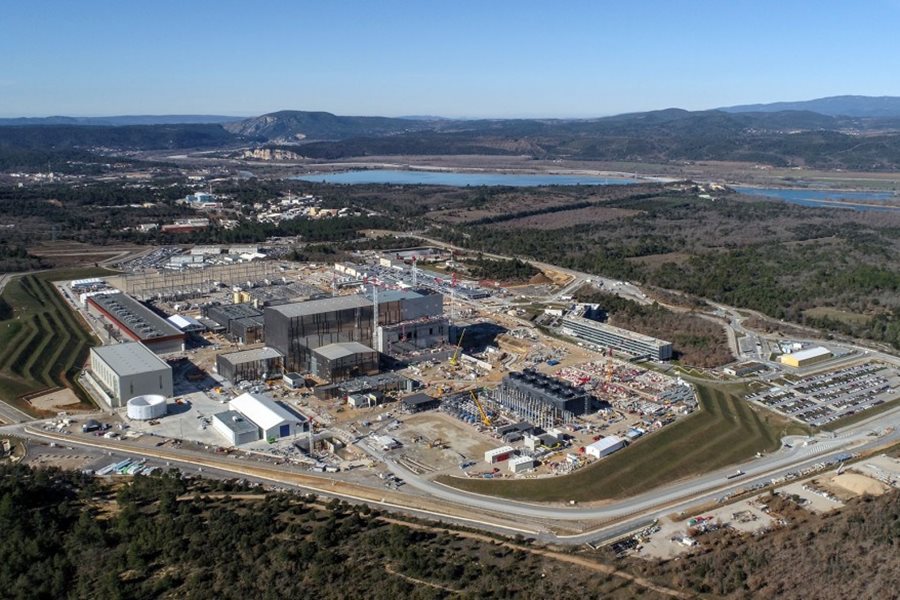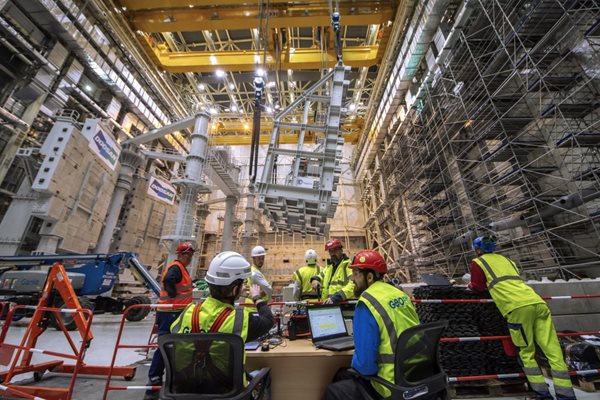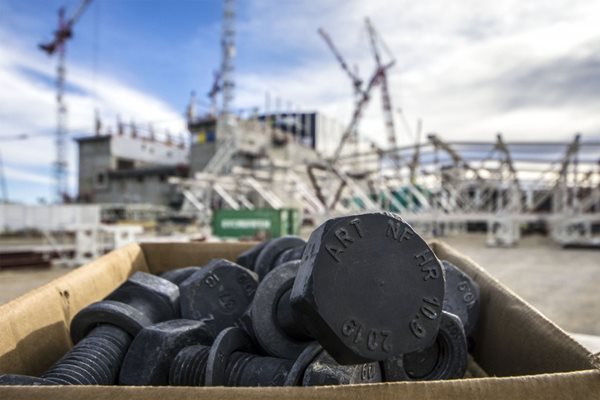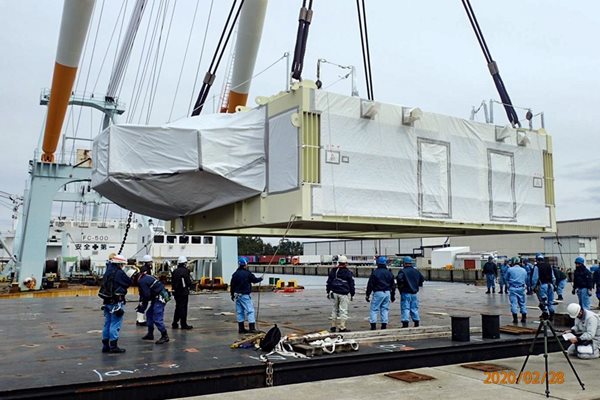
you're currently reading the news digest published from 24 Feb 2020 to 02 Mar 2020
featured4
press6
featured
From up high | A drone survey amidst the "giboulées"
It is March in Provence and with the last month of winter comes a peculiar weather pattern that the French call « giboulées »—alternating showers and sunshine, cold spells sometimes accompanied with snow, and days that already feel like late spring. A drone operator needs to be something of a meteorologist—when surveying the ITER site, it is important to take into consideration the hour of the day and the angle of the sun. There are parts of the ITER site that shine only in the early morning light, others that are at their best in the slanting afternoon sun exclusively. Emmanuel Riche, who has flown his drone over ITER since 2015, did his last survey amidst giboulées, but managed to capture, once again, the spectacular beauty of the site and the imposing presence of its many buildings. As always, the Tokamak Complex is stealing the show. The 400,000-tonne edifice has changed a lot since it was last photographed from up high in October of last year. At the time, the first pillars of the future crane hall were just being installed on both sides of the central Tokamak Building. Four month later, the steel structure is complete and cladding is progressing fast. What happens inside (and a lot is happening) is now unfortunately hidden from view. The roof now blocks the view of the bioshield's familiar shape. By comparing the present images to the ones taken last October, one can play the 'spot the differences' game. There are particularly striking at the north end of the platform, where progress on the heat rejection zone has been spectacular, and one long-time essential facility for the construction of ITER—the concrete batching plant—has simply disappeared. This week's ITER NOW video (1.5) features Emmanuel Riche and his work. You can view it here.
Assembly rehearsal | Upending the steel cradle
Load handling will play an essential role in the assembly of the ITER Tokamak. Very large, very heavy, very delicate and very costly components will need to be lifted, transported and manoeuvred without damage, often through highly constricted environments. Travelling the entire length of the assembly space (~ 170 metres) the overhead cranes will be the workhorses of the machine assembly phase. For the five years to come, these massive high-precision tools will hold in their hoists and hooks the future of the ITER installation. 'The tasks we have before us are very complicated, and some of them have never been done before,' says Bob Shaw, who coordinates machine assembly operations at ITER. 'But our philosophy is quite simple: we want to check and test everything possible before actually handling the components.' Bob, his ITER colleagues and the contractors involved in the assembly activities are testing 'processes'—not just the lifting system and the loads to be handled, but their interaction and the whole kinematics of upending, transporting and manipulating charges that can be as heavy as four fully loaded Boeing 747s. 'The more you prepare, the fewer problems you are likely to encounter,' says Bob. 'What we are doing is out of an abundance of caution.' Last week's operation was one of the very first steps into the testing of some of the processes that will be implemented in the upcoming assembly phase. One of the most delicate operations that the team will soon face is the handling of the vacuum vessel sectors and the D-shaped toroidal field coils that need be combined into 'sub-assemblies' before they are lowered into the Tokamak pit. Prior to their transfer into the 'wings' of the sector sub-assembly tools (SSATs), the very large and very heavy components will need to transition from their horizontal delivery positions to upright. A bespoke lifting device (the 'upending tool') has been designed for this purpose. Like a massive steel cradle, it will accommodate the components during the horizontal-to-vertical transition, before their subsequent transfer to the SSATs. Last week's 'dry run' with the empty upending tool has already delivered a wealth of data. The team now knows where to make improvements—such as slight adaptations to the cranes' software—and photogrammetry has provided a 'baseline' for deformation reference. In about one month, when the cranes are available again¹, another series of tests will be performed, this time with loads representative of the actual components. (¹) The cranes are now being moved to the Tokamak Building to undergo a month-long series of commissioning and load tests designed to set up the cranes, and demonstrate the structural integrity of the load path. Click here to view a time-lapse video.
"Sans Titre" | A humble connector of art and science
Sometimes a bolt is just a bolt. Sometimes it is more. On the morning of 13 November 2019, fresh from celebrating the completion of civil works on the Tokamak Building, ITER Director-General Bernard Bigot could be seen donning a safety harness and ascending in a cherry picker to a selected spot in the emerging roof structure of the crane hall. In his hand was a black bolt, indistinguishable from any other except for the inscription: ART. Working by hand, he inserted the small cylindrical object—in engineering terms an M30 hexbolt precisely fabricated from A-490 Type 3 alloy steel with a black iron-oxide finish—into two perfectly aligned holes, threading on the hex-nut to join a set of white steel beams. As an engineer added the precise torque and the bolt settled permanently into its place, it became Sans Titre, a work of art anonymously embedded in a work of science. Tens of thousands of M30 bolts connect the muscular steel elements of the Tokamak Building roof structure. As a functional unit, the massive roof framework must support the twin tracks of the overhead crane—which in turn must carry components weighing as much as 1,300 tonnes, manoeuvring each one gently into its place in the ITER Tokamak. Sans Titre is one bolt among many. What makes it special? The answer is in the intention. Sans Titre is the work of New York sculptor Christine Corday. Corday is no stranger to massive steel structures and high temperatures. She has frequently used plasma as an art medium, a variety of metals serving as her "palette" in the creation of a sculpture, and she was the first artist invited to use NASA's Remotely Coupled Transferred Arc (RCTA) Plasma System at temperatures exceeding 22,000 °C. When Corday learned about ITER, she saw poetry in the human narrative, the decades of research coming to fruition. As Corday said in a recent Forbes article, "There's thousands of engineers, thousands of scientists, thousands of builders. It's truly extraordinary to think that we are the witnessing generation of a star being built on Earth." Within that human endeavour, Sans Titre is Corday's statement of Art's support for ITER as "science's greatest terrestrial achievement of the celestial." It is Art, not as decoration, but as a contributing and sustained presence. Why choose a bolt? The anonymity of Sans Titre, inserted as one M30 bolt among many and disappearing into the structure of the Tokamak Complex, is exactly the point: in the human narrative, Art and Science inextricably merge. Corday likens it to a specific place in Rachmaninoff's Prelude in C Sharp Minor, in which the opening fortissimo bars are followed in pianisissimo, very softly, by three chords played—according to the composer's instruction—with the fingers of the pianist's left hand inserted into those of the right, the thumbs touching and interlocking. When the two thumbs touch, Corday says, a unique moment is achieved; this is much like Sans Titre functioning side by side with the other M30 bolts, "a sustained material moment within the infrastructure of this promethean site." Director-General Bigot sees a similar significance: "I am really pleased that Christine Corday selected a bolt as the component that she would contribute to ITER. Bolts are the links that connect the pieces of the machine and structure, in the same way that artists and scientists serve as links to bring our society together and advance our culture." As Bigot sees it: "Art and science are two human activities that have a lot of similarity to each other. You invent a new world. You explore beyond the known frontiers. You call upon emotion and rationality. The results are supposed to be universally shared to create links between people. It is a critical part of our culture and identity. Many scientists have strong arts interests; and many artists are deeply interested in science, humbly seeking introductions to gain understanding." As humans, we dream. The particles from which we are fabricated are the stuff of stars, configured over countless millennia into a peculiar species that seeks to imagine and shape its own future: in art, in science, and in their blended narrative. In the quest to recreate and harness fusion, the force that enables and sustains our existence, there is a certain poetry. Corday's work is a fresh expression of that "material conversation." Learn more about the work of Christine Corday here.
Image of the week | First coil heads to sea
ITER's first toroidal field coil is about to embark on a month-long voyage from the port of Kobe, Japan, to Fos-sur-Mer, France. Component and packaging together weigh nearly 500 tonnes. A heart of niobium-tin and copper, a case of stainless steel as much as 12 centimetres thick, and a sturdy transport frame—ITER's first D-shaped toroidal field coil represents a major load to be handled and transported. The component left Mitsubishi Heavy Industries (Futami Port) on 29 February for transfer by barge to the port of Kobe. It will be transferred by crane to an oceangoing vessel—the well-named UHL Fusion—this week. Shipping is expected to take approximately one month.



